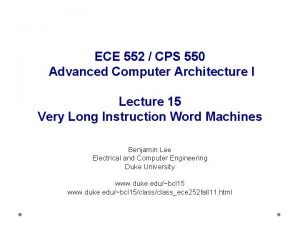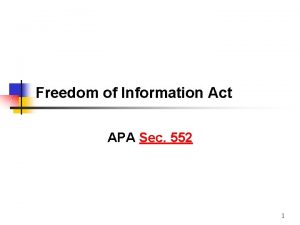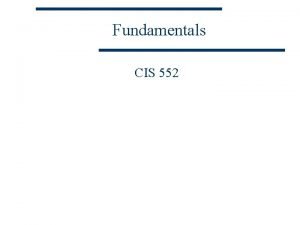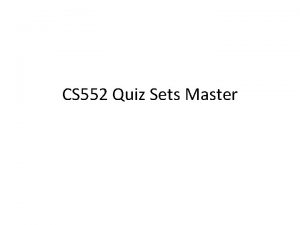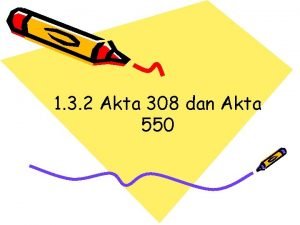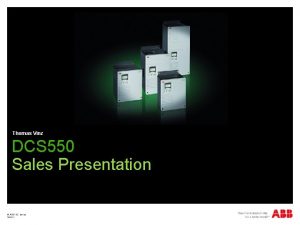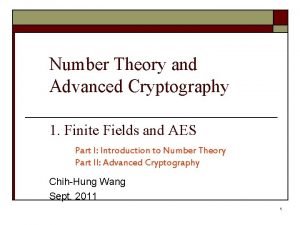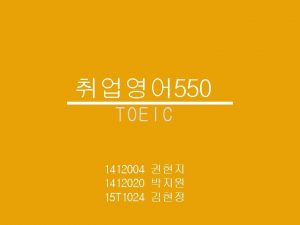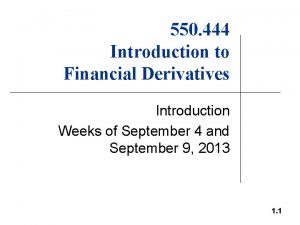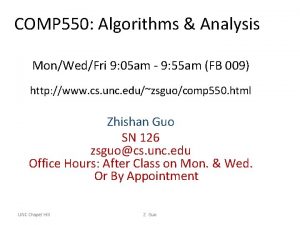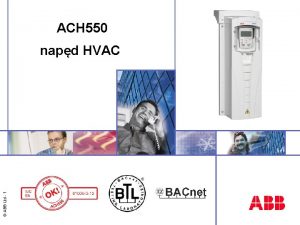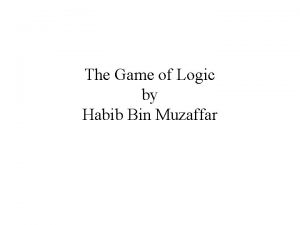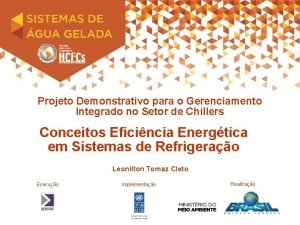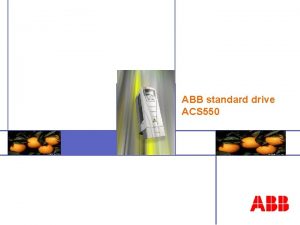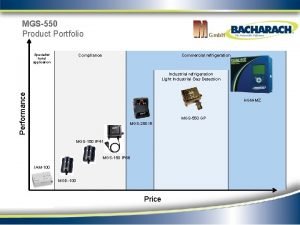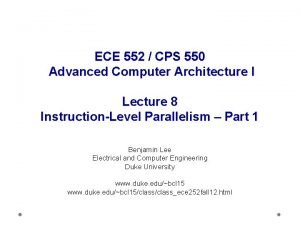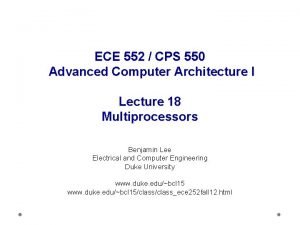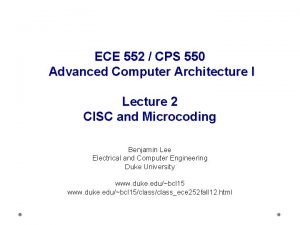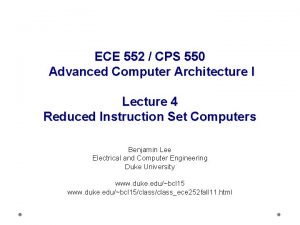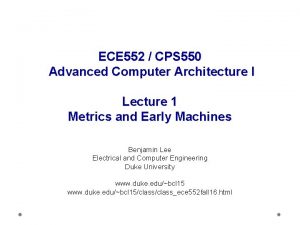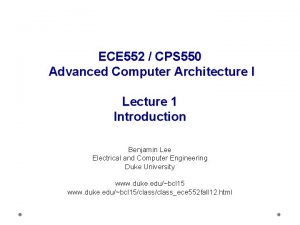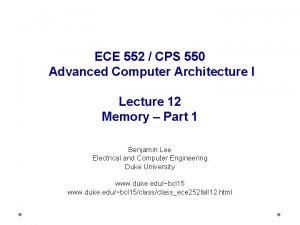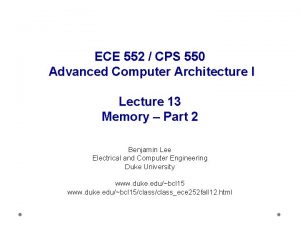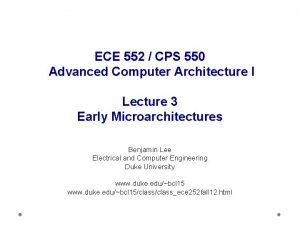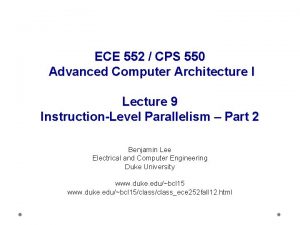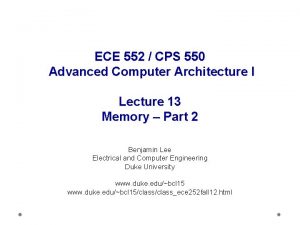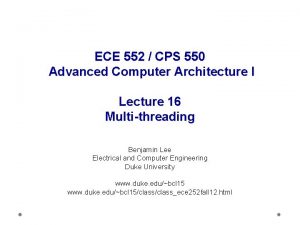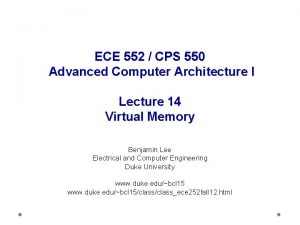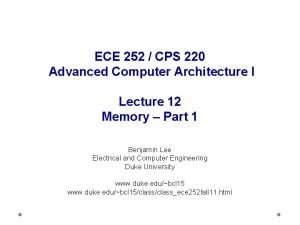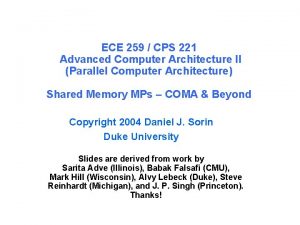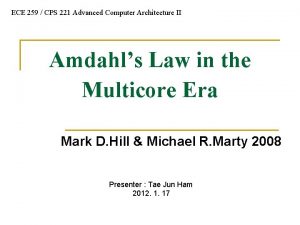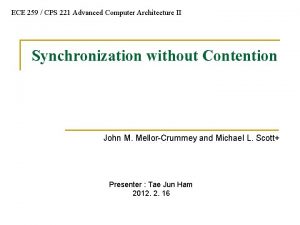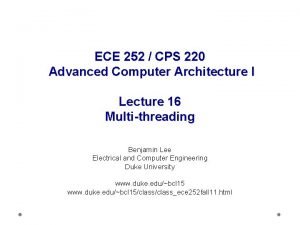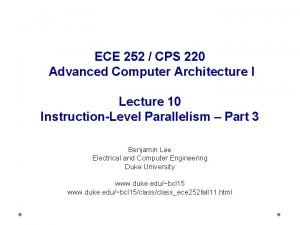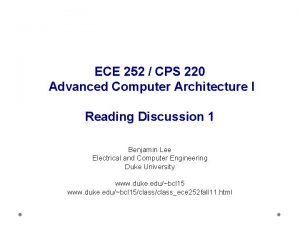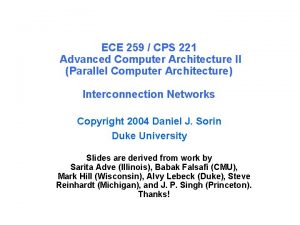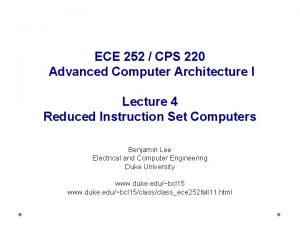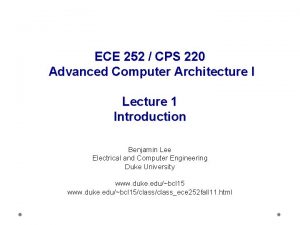ECE 552 CPS 550 Advanced Computer Architecture I













![Loop Execution for (i=0; i<N; i++) B[i] = A[i] + C; Compile loop: ld Loop Execution for (i=0; i<N; i++) B[i] = A[i] + C; Compile loop: ld](https://slidetodoc.com/presentation_image_h/23d6cef79d63e25671eb95e378f7d3d1/image-14.jpg)
![Loop Unrolling for (i=0; i<N; i++) B[i] = A[i] + C; - - for Loop Unrolling for (i=0; i<N; i++) B[i] = A[i] + C; - - for](https://slidetodoc.com/presentation_image_h/23d6cef79d63e25671eb95e378f7d3d1/image-15.jpg)


![Software Pipelining (Illustrated) Not pipelined load A[0] C Pipelined + load A[1] C load Software Pipelining (Illustrated) Not pipelined load A[0] C Pipelined + load A[1] C load](https://slidetodoc.com/presentation_image_h/23d6cef79d63e25671eb95e378f7d3d1/image-18.jpg)












- Slides: 30

ECE 552 / CPS 550 Advanced Computer Architecture I Lecture 15 Very Long Instruction Word Machines Benjamin Lee Electrical and Computer Engineering Duke University www. duke. edu/~bcl 15/class_ece 252 fall 11. html

ECE 252 Administrivia 13 November – Homework #4 Due Project Proposals Should receive comments by end of week. ECE 552 / CPS 550 2

Oo. O Superscalar Complexity Out-of-order Superscalar - Objective: Increase instruction-level parallelism. Cost: Hardware logic/mechanisms to track dependencies and dynamically schedule independent instructions. Hardware Complexity - Instructions can issue, complete out-of-order. Instructions must commit in-order Implement Tomasulo’s algorithm with a variety of structures Example: Reservation stations, reorder buffer, physical register file Very Long Instruction Word (VLIW) - Objective: Increase instruction-level parallelism. Cost: Software compilers/mechanisms to track dependencies and statically schedule independent instructions. ECE 552 / CPS 550 3

Review of Fetch/Decode Fetch - Load instruction by accessing memory at program counter (PC) Update PC using sequential address (PC+4) or branch prediction (BTB) Decode/Rename - Take instruction from fetch buffer Allocate resources, which are necessary to execute instruction: (1) Destination physical register – if instruction writes a register, rename (2) Reorder buffer (ROB) entry – support in-order commit (3) Issue queue entry – hold instruction as it waits for execution (4) Memory buffer entry – resolve dependencies through memory (next slide) - Stall if resources unavailable Rename source/destination registers Update reorder buffer, issue queue, memory buffer ECE 552 / CPS 550 4

Review of Memory Buffer Allocate memory buffer entry Store Instructions - Calculate store-address and place in buffer Take store-data and place in buffer Instruction commits in-order when store-address, store-data ready Load Instructions - Calculate load-address and place in buffer Instruction searches memory buffer for stores with matching address Forward load data from in-flight stores with matching address Stall load if buffer contains stores with un-resolved addresses ECE 552 / CPS 550 5

Review of Issue/Execute Issue - Instruction commits from reorder buffer A commit wakes-up an instruction by marking its sources ready Select logic determines which ready instructions should execute Issue when by sending instructions to functional unit Execute - Read operands from physical register file and/or forwarding path Execute instruction in functional unit Write result to physical register file, store buffer Produce exception status Write to reorder buffer ECE 552 / CPS 550 6

Review of Commit - Instructions can complete and update reorder buffer out-of-order Instructions commit from reorder buffer in-order Exceptions - Check for exceptions If exception raised, flush pipeline Jump to exception handler Release Resources - Free physical register used by last writer to same architected register Free reorder buffer slot Free memory buffer slot ECE 552 / CPS 550 7

Control Logic Scaling Issue Width W Issue Group Previously Issued Instructions Lifetime L - Lifetime (L) – number of cycles an instruction spends in pipeline Lifetime depends on pipeline latency, time spent in reorder buffer Issue width (W) – maximum number of instructions issued per cycle - As W increases, issue logic must find more instructions to execute in parallel and keep pipeline busy. More instructions must be fetched, decoded, and queued. W x L instructions can impact any of the W issuing instructions (e. g. forwarding) and growth in hardware proportional to W x (W x L) - ECE 552 / CPS 550 8

Control Logic (MIPS R 10000) Control Logic ECE 552 / CPS 550 9

Sequential Instruction Sets Sequential source code Superscalar compiler Sequential machine code a = foo(b); for (i=0, i< Find independent operations Schedule operations Superscalar processor Check instruction dependencies ECE 552 / CPS 550 Schedule execution 10

Sequential Instruction Sets Superscalar Compiler - Takes sequential code (e. g. , C, C++) Check instruction dependencies Schedule operations to preserve dependencies Produces sequential machine code (e. g. , MIPS) Superscalar Processor - Takes sequential code (e. g. , MIPS) Check instruction dependencies Schedule operations to preserve dependencies Inefficiency of Superscalar Processors - Performs dependency, scheduling dynamically in hardware Expensive logic rediscovers schedules that a compiler could have found ECE 552 / CPS 550 11

VLIW – Very Long Instruction Word Int Op 1 Int Op 2 Mem Op 1 Mem Op 2 FP Op 1 FP Op 2 Two Integer Units, Single Cycle Latency Two Load/Store Units, Three Cycle Latency - Two Floating-Point Units, Four Cycle Latency Multiple operations packed into one instruction format Instruction format is fixed, each slot supports particular instruction type Constant operation latencies are specified (e. g. , 1 cycle integer op) Software schedules operations into instruction format, guaranteeing (1) Parallelism within an instruction – no RAW checks between ops (2) No data use before ready – no data interlocks/stalls ECE 552 / CPS 550 12

VLIW Compiler Responsibilities Schedule operations to maximize parallel execution - Fill operation slots Guarantee intra-instruction parallelism - Ensure operations within same instruction are independent Schedule to avoid data hazards - Separate options with explicit NOPs ECE 552 / CPS 550 13
![Loop Execution for i0 iN i Bi Ai C Compile loop ld Loop Execution for (i=0; i<N; i++) B[i] = A[i] + C; Compile loop: ld](https://slidetodoc.com/presentation_image_h/23d6cef79d63e25671eb95e378f7d3d1/image-14.jpg)
Loop Execution for (i=0; i<N; i++) B[i] = A[i] + C; Compile loop: ld f 1, 0(r 1) add r 1, 8 fadd f 2, f 0, f 1 sd f 2, 0(r 2) add r 2, 8 bne r 1, r 3, loop - Int 1 Int 2 loop: add r 1 M 2 FP+ FPx ld fadd Schedule add r 2 bne sd The latency of each instruction is fixed (e. g. , 3 cycle ld, 4 cycle fadd) Instr-1: Load A[i] and increment i (r 1) in parallel Instr-2: Wait for load Instr-3: Wait for add. Store B[i], increment i (r 2), branch in parallel How many flops / cycle? 1 fadd / 8 cycles = 0. 125 ECE 552 / CPS 550 14
![Loop Unrolling for i0 iN i Bi Ai C for Loop Unrolling for (i=0; i<N; i++) B[i] = A[i] + C; - - for](https://slidetodoc.com/presentation_image_h/23d6cef79d63e25671eb95e378f7d3d1/image-15.jpg)
Loop Unrolling for (i=0; i<N; i++) B[i] = A[i] + C; - - for (i=0; i<N; i+=4) { B[i] = A[i] + C; B[i+1] = A[i+1] + C; B[i+2] = A[i+2] + C; B[i+3] = A[i+3] + C; } ECE 552 / CPS 550 Unroll inner loop to perform k iterations of computation at once. If N is not a multiple of unrolling factor k, insert clean-up code Example: unroll inner loop to perform 4 iterations at once 15

Scheduling Unrolled Loops loop: ld f 1, 0(r 1) ld f 2, 8(r 1) ld f 3, 16(r 1) ld f 4, 24(r 1) add r 1, 32 fadd f 5, f 0, f 1 fadd f 6, f 0, f 2 fadd f 7, f 0, f 3 fadd f 8, f 0, f 4 sd f 5, 0(r 2) sd f 6, 8(r 2) sd f 7, 16(r 2) sd f 8, 24(r 2) add r 2, 32 bne r 1, r 3, loop ECE 552 / CPS 550 Int 1 loop: add r 1 Int 2 M 1 ld f 2 ld f 3 ld f 4 schedule sd f 5 sd f 6 sd f 7 add r 2 bne sd f 8 - M 2 FP+ FPx fadd f 5 fadd f 6 fadd f 7 fadd f 8 Unroll loop to execute 4 iterations Reduces number of empty operation slots How many flops/cycle? 4 fadds / 11 cycles = 0. 36 16

Software Pipelining Exploit independent loop iterations - If loop iterations are independent, then get more parallelism by scheduling instructions from different iterations - Example: Loop iterations are independent in the code sequence below. Construct the data-flow graph for one iteration load A[i] for (i=0; i<N; i++) B[i] = A[i] + C; C + store B[i] ECE 552 / CPS 550 17
![Software Pipelining Illustrated Not pipelined load A0 C Pipelined load A1 C load Software Pipelining (Illustrated) Not pipelined load A[0] C Pipelined + load A[1] C load](https://slidetodoc.com/presentation_image_h/23d6cef79d63e25671eb95e378f7d3d1/image-18.jpg)
Software Pipelining (Illustrated) Not pipelined load A[0] C Pipelined + load A[1] C load A[2] C + Steady State + store B[1] C + Drain store B[2] load A[3] Load A[0] C + load A[1] C store B[0] + load A[2] C store B[1] + load A[3] C store B[2] + load A[4] C store B[3] + load A[5] C store B[4] + Fill store B[0] store B[5] store B[3] ECE 552 / CPS 550 18

Scheduling SW Pipelined Loops Unroll the loop to perform 4 iterations at once. Then SW pipeline. for (i=0; i<N; i++) B[i] = A[i] + C; Int 1 Int 2 loop: ld f 1, 0(r 1) add r 1 ld f 2, 8(r 1) fill ld f 3, 16(r 1) ld f 4, 24(r 1) add r 1, 32 add r 1 fadd f 5, f 0, f 1 fadd f 6, f 0, f 2 loop: steady fadd f 7, f 0, f 3 state fadd f 8, f 0, f 4 add r 2 sd f 5, 0(r 2) add r 1 bne sd f 6, 8(r 2) sd f 7, 16(r 2) add r 2, 32 add r 2 drain sd f 8, -8(r 2) bne r 1, r 3, loop ECE 552 / CPS 550 M 1 M 2 FP+ FPx ld f 1 ld f 2 ld f 3 ld f 4 ld f 1 fadd f 5 fadd f 6 ld f 2 ld f 3 ld f 4 ld f 1 ld f 2 ld f 3 ld f 4 sd f 5 sd f 6 sd f 7 sd f 8 sd f 5 fadd f 7 fadd f 8 fadd f 5 fadd f 6 fadd f 7 fadd f 8 fadd f 5 sd f 6 fadd f 6 sd f 7 fadd f 7 sd f 8 fadd f 8 sd f 5 19

What if there are no loops? Basic block ECE 552 / CPS 550 - Basic block defined by sequence of consecutive instructions. Every basic block ends with a branch. - Instruction-level parallelism is hard to find in basic blocks - Basic blocks illustrated by control flow graph 21

Trace Scheduling ECE 552 / CPS 550 - A trace is a sequence of basic blocks (a. k. a. , long string of straight-line code) - Trace Selection: Use profiling or compiler heuristics to find common sequences/paths - Trace Compaction: Schedule whole trace into few VLIW instructions. - Add fix-up code to cope with branches jumping out of trace. Undo instructions if control flower diverges from trace. 22

Problems with “Classic” VLIW Object Code Challenges - - Compatibility: Need to recompile code for every VLIW machine, even across generations. Compatibility: Code specific to operation slots in instruction format and latencies of operations Code Size: Instruction padding wastes instruction memory/cache with nops for unfilled slots. Code Size: Loop unrolling, software pipelining increases code footprint. Scheduling Variable Latency Operations - Effective schedules rely on known instruction latencies Caches, memories produce unpredictable variability ECE 552 / CPS 550 23

Problems with “Classic” VLIW Object Code Challenges - - Compatibility: Need to recompile code for every VLIW machine, even across generations. Compatibility: Code specific to operation slots in instruction format and latencies of operations Code Size: Instruction padding wastes instruction memory/cache with nops for unfilled slots. Code Size: Loop unrolling, software pipelining increases code footprint. Scheduling Variable Latency Operations - Effective schedules rely on known instruction latencies Caches, memories produce unpredictable variability ECE 552 / CPS 550 24

Intel Itanium, EPIC IA-64 Explicitly Parallel Instruction Computing (EPIC) - Computer architecture style (e. g. , CISC, RISC, EPIC) IA-64 - Instruction set architecture (e. g. , x 86, MIPS, IA-64) IA-64 – Intel Architecture 64 -bit Implementations - Merced, first implementation, 2001 Mc. Kinley, second implementation, 2002 Poulson, recent implementation, 2011 ECE 552 / CPS 550 25

Intel Itanium, EPIC IA-64 - Eight cores - 1 -cycle 16 KB L 1 I&D caches - 9 -cycle 512 KB L 2 I-cache - 8 -cycle 256 KB L 2 D-cache - 32 MB shared L 3 cache - 544 mm 2 in 32 nm CMOS - 3 billion transistors - Cores are 2 -way multithreaded - Each VLIW word is 128 -bits, containing 3 instructions (op slots) - Fetch 2 words per cycle 6 instructions (op slots) - Retire 4 words per cycle 12 instructions (op slots) ECE 552 / CPS 550 26

VLIW and Control Flow Challenges Challenge - Mispredicted branches limit ILP Trace selection groups basic blocks into larger ones Trace compaction schedules instructions into a single VLIW Requires fix-up code for branches that exit trace Solution – Predicated Execution - Eliminate hard to predict branches with predicated execution IA-64 instructions can be executed conditionally under predicate Instruction becomes a NOP if predicate register is false ECE 552 / CPS 550 28

VLIW and Control Flow Challenges b 0: Inst 1 Inst 2 br a==b, b 2 if b 1: Inst 3 Inst 4 br b 3 else Predication b 2: Inst 5 Inst 6 then Inst 1 Inst 2 p 1, p 2 <- cmp(a==b) (p 1) Inst 3 || (p 2) Inst 5 (p 1) Inst 4 || (p 2) Inst 6 Inst 7 Inst 8 One basic block b 3: Inst 7 Inst 8 Four basic blocks ECE 552 / CPS 550 On average >50% branches removed. Mahlke et al. 1995. 29

Limits of Static ILP Software Instruction-level Parallelism (VLIW) - Compiler complexity Code size explosion Unpredictable branches Variable memory latency and unpredictable cache behavior Current Status - Despite several attempts, VLIW has failed in general-purpose computing VLIW hardware complexity similar to in-order, superscalar hardware complexity. Limited advantage on large, complex applications Successful in embedded digital signal processing; friendly code ECE 552 / CPS 550 30

Summary Out-of-order Superscalar • Hardware complexity increases super-linearly with issue-width. Very Long Instruction Word (VLIW) • • Compiler explicitly schedules parallel instructions Unrolling and software pipelining loops Predication • • • Mitigates branches in VLIW machines Predicate operations. If predicate false, operation does not affect architected state. Mahlke et al. “A comparison of full and partial predicated execution support for ILP processors” 1995. ECE 552 / CPS 550 31

Acknowledgements These slides contain material developed and copyright by - Arvind (MIT) - Krste Asanovic (MIT/UCB) - Joel Emer (Intel/MIT) - James Hoe (CMU) - Arvind Krishnamurthy (U. Washington) - John Kubiatowicz (UCB) - Alvin Lebeck (Duke) - David Patterson (UCB) - Daniel Sorin (Duke) ECE 552 / CPS 550 32
 Ece 552
Ece 552 Ece 552
Ece 552 Omd 552 hospital waste management
Omd 552 hospital waste management Guardas y protecciones de equipos
Guardas y protecciones de equipos Sec552
Sec552 +1 (617) 552-2015
+1 (617) 552-2015 Cis 552
Cis 552 Quiz
Quiz Ec 6009
Ec 6009 Bus design in computer architecture
Bus design in computer architecture Difference between organization and architecture
Difference between organization and architecture Simple computer design
Simple computer design 603 550 israelites
603 550 israelites Byzantine empire 550 ad
Byzantine empire 550 ad 550 poirier st coquitlam bc
550 poirier st coquitlam bc Akta 308
Akta 308 Abb dcs 550
Abb dcs 550 Inverse of 550 in gf(1759)
Inverse of 550 in gf(1759) 300 e yuvarlanabilen en büyük sayı
300 e yuvarlanabilen en büyük sayı Toeic 550
Toeic 550 550-444
550-444 550 en romanos
550 en romanos Unc comp 550
Unc comp 550 Ach 550
Ach 550 5+5+5=550
5+5+5=550 Ahri
Ahri Gupta sculpture
Gupta sculpture 550
550 550+330
550+330 Telit sat 550
Telit sat 550 Mgs550
Mgs550
